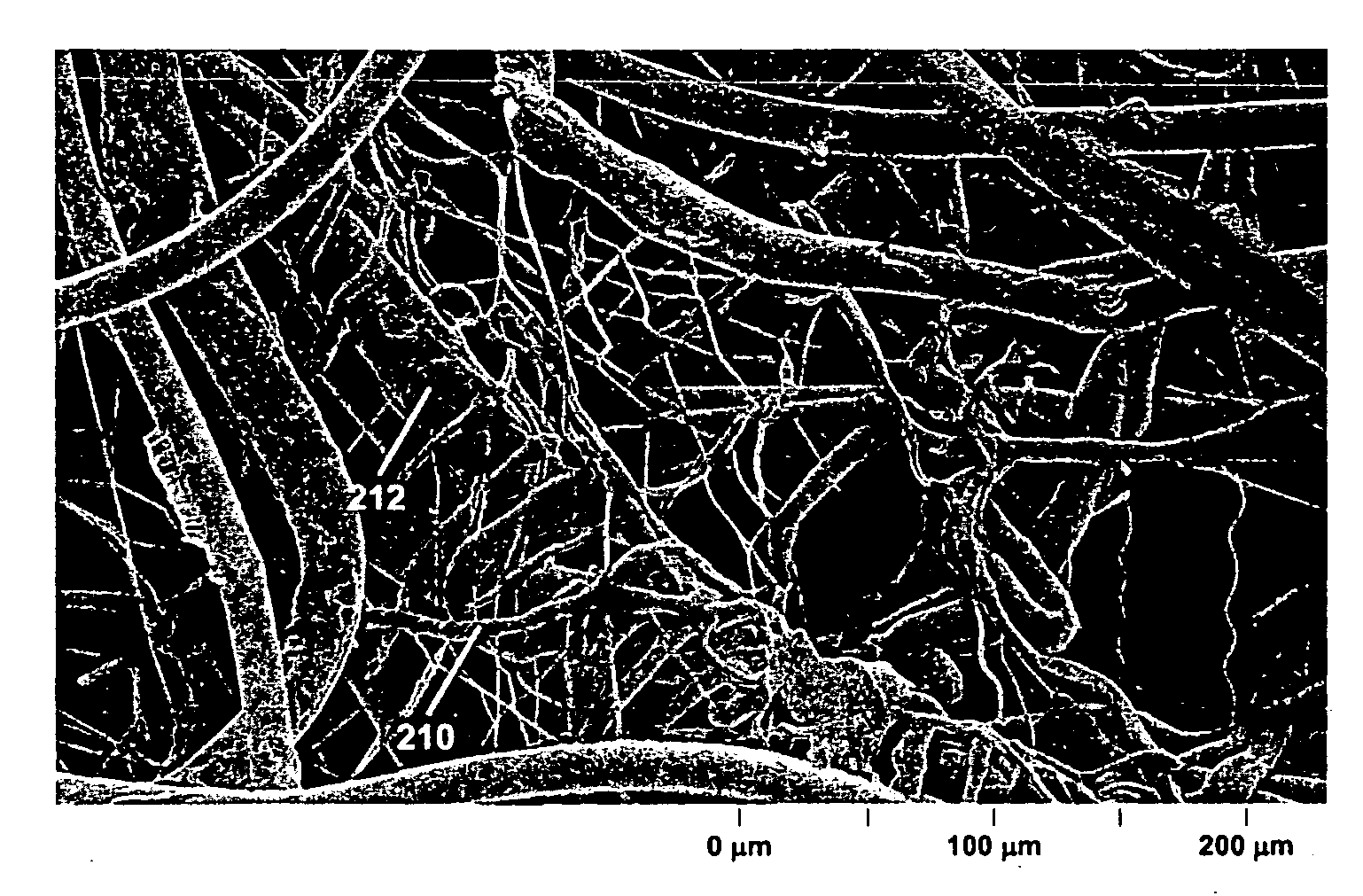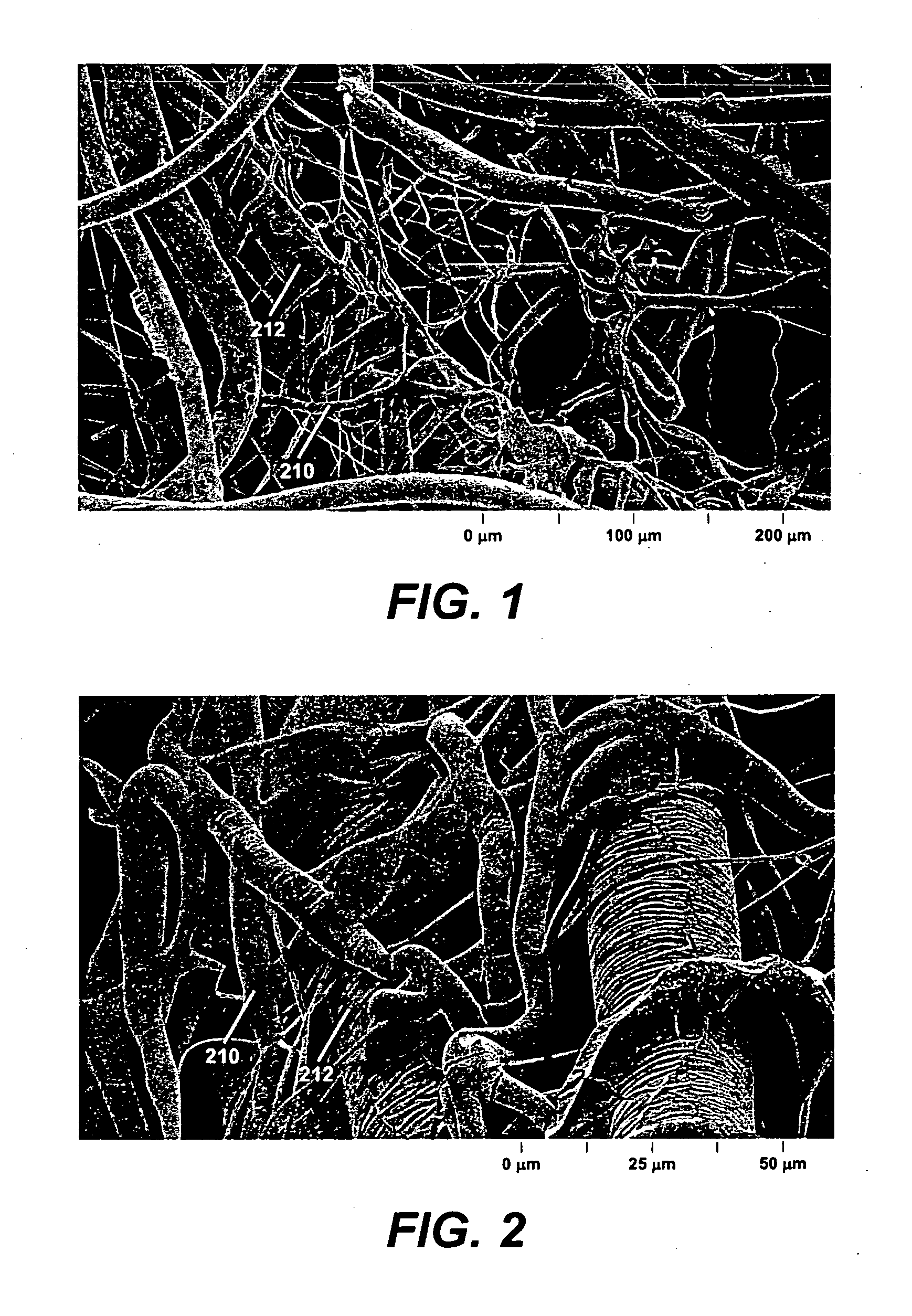Biaxially stretchable outer cover for an absorbent article
- Summary
- Abstract
- Description
- Claims
- Application Information
AI Technical Summary
Benefits of technology
Problems solved by technology
Method used
Image
Examples
example 1
[0130]Sample 1A was a spunbond material formed from a layer of elastomeric fibers (“Sel”; V2120 fiber-grade VISTAMAXX elastomeric polypropylene) having a basis weight of 30 g / m2. Sample 1B was a composite nonwoven material formed from a layer of elastic meltblown fibers (“Mel”; V2120 elastomeric polypropylene) having a basis weight of 4 g / m2 in between two layers of elastic spunbond fibers (V2120 elastomeric polypropylene) each having a basis weight of 15 g / m2. The spunbond and meltblown fibers had nominal diameters of about 20 μm or more and about 1 μm, respectively.
[0131]Samples 1A and 1B were activated in a hydraulic press using a set of flat plates (pitch of 0.100″ or 2.5 mm), to a depth of engagement of about 2.5 mm in either the CD only or in both MD and CD. FIGS. 1 and 2 are the SEMs of Sample 1B prior to and after activation, respectively. The changes in sample dimensions produced during mechanical activation were subsequently subjected to a hysteresis test to determine the ...
example 2
[0132]Sample 2A was a spunbond material formed from two superimposed layers of elastomeric fibers (V2120 fiber-grade VISTAMAXX elastomeric polypropylene) each having a basis weight of 30 g / m2. Sample 2B was a thermally bonded composite nonwoven material formed from a layer of elastic nanofibers (“Nel”; V2120 elastomeric polypropylene) having a basis weight of 5 g / m2 in between two layers of elastic spunbond fibers (V2120 elastomeric polypropylene) each having basis weight of 30 g / m2. The spunbond and meltblown fibers had nominal diameters of about 20 μm or more and less than about 1 μm, respectively.
[0133]Samples 2A and 2B were analyzed according to the opacity test. FIG. 3 is the SEM of Sample 2B prior to mechanical activation. The results are summarized in Table 2.
TABLE 2BasisOpacitySampleMaterialWeight(%)2ASel60 g / m243%2BSelNelSel65 g / m252%
[0134]The results in Table 2 illustrate the ability of the interlayer nanofibers to improve the aesthetic properties of the BSOC by substantia...
example 3
[0135]The samples of Example 3 illustrate the tensile properties of nonwoven plastoelastic materials formed from a mixture of elastomeric fibers (V2120 fiber-grade VISTAMAXX elastomeric polypropylene) and plastic fibers (polyolefin-based). Table 3A lists the various samples tested, the approximate relative amounts of elastomeric fibers and plastic fibers in each sample, and the nominal basis weights of the mixed fiber sample.
TABLE 3ANominalBasisElastomericPlasticSampleWeightComponentComponent3A25 g / m2100 wt. % 0 wt. %3B25 g / m250 wt. %50 wt. %3C35 g / m250 wt. %50 wt. %3D45 g / m250 wt. %50 wt. %3E25 g / m258 wt. %42 wt. %3F35 g / m258 wt. %42 wt. %3G45 g / m258 wt. %42 wt. %
[0136]The tensile properties of Samples 3B-3G were tested after activation in both the CD and MD using a set of flat plates placed in a hydraulic press. Activation was performed at intermediate strain rate values, such as, for example strain rates of between about 1 sec−1 and about 50 sec−1, and a depth of engagement of a...
PUM
| Property | Measurement | Unit |
|---|---|---|
| Fraction | aaaaa | aaaaa |
| Fraction | aaaaa | aaaaa |
| Fraction | aaaaa | aaaaa |
Abstract
Description
Claims
Application Information
 Login to View More
Login to View More - R&D
- Intellectual Property
- Life Sciences
- Materials
- Tech Scout
- Unparalleled Data Quality
- Higher Quality Content
- 60% Fewer Hallucinations
Browse by: Latest US Patents, China's latest patents, Technical Efficacy Thesaurus, Application Domain, Technology Topic, Popular Technical Reports.
© 2025 PatSnap. All rights reserved.Legal|Privacy policy|Modern Slavery Act Transparency Statement|Sitemap|About US| Contact US: help@patsnap.com



